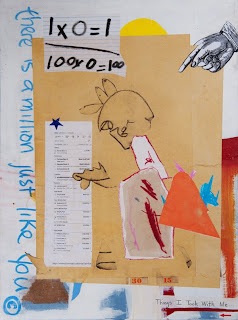 Colin Wiita was born in Duluth in 1974. I first noticed his art at the second annual “Love Your Local Artist” event at the Superior Library. Specifically it was his conversation with Clyfford Still, titled “Still Conversation,” that caught my attention and caused me to pay greater attention to his other pieces. He is currently married and a father of three children, ages 4 to 9, and lives in rural Wisconsin.
Colin Wiita was born in Duluth in 1974. I first noticed his art at the second annual “Love Your Local Artist” event at the Superior Library. Specifically it was his conversation with Clyfford Still, titled “Still Conversation,” that caught my attention and caused me to pay greater attention to his other pieces. He is currently married and a father of three children, ages 4 to 9, and lives in rural Wisconsin.EN: How did you first take an interest in art? Did you study art in school?
Colin Wiita: My first experience with art was through the pen and ink drawings that my father did when I was a child. Although I have not seen these drawings in over 30 years I still have vivid memories of what they contain. I personally didn’t get into art until junior high where I had an art teacher who engaged his students in a way that stuck with me. I’ve been making art since junior high school, but did not get serious about it until 2004 when I began to study art at the University of Wisconsin Superior. I received my Masters in Art with an emphasis on Studio Art in spring 2011.
E: Who have been your biggest influences as an artist?
CW: My family has been the biggest influence on me. My father is a musician and my mother instilled in me a love of art by taking me to many art museums during my youth. My wife and children constantly support and influence my art work. There’s a long list of artists who inspire me, and as I explore the art world more come into play all the time. A few that grabbed my attention in my studies at UWS were Robert Rauschenberg, Basquiat, and Picasso.
 E: What has been the inspiration behind your current work?
E: What has been the inspiration behind your current work?CW: My current work is inspired by my children. The freedom that they show in the drawings and paintings they create helps me lighten my control over the images that I create. This allows the works to develop on their own rather than being stuck in the idea that inspired them. I have found that when the idea comes out of the images it is more coherent than when I am force the idea upon the image.
E: Why is making art important to you?
CW: Making art is what makes life important to me. The constant challenge, success and failures that come with making art keep me engaged in every aspect of my life. To say my well-being depends on making art is an understatement.
 E: What is your studio or work space like? Can you describe it?
E: What is your studio or work space like? Can you describe it?CW: My studio is currently in my basement which I enjoy because it gives me access to my work at all times. The lighting is artificial, and the space is unfinished, but I have filled it with artwork and objects I plan to use for works. I always work standing up as I feel that I have a better range of motion. I work off two large tables and an easel. I have learned to work on a number of pieces at a time, some big some small. I find that having my current work out gives me time to digest the images and think about how to solve the next problem I feel lies within the work. This process overall makes the works I am creating a part of my everyday life.
E: What kind of music do you listen to when you’re painting?
CW: Music is a large factor to the artwork I create. I come from a highly musical family and the inspiration I get from music is immense. To describe the music I listen to is hard. I feel that alternative is too broad of a term, but the music I listen too is usually a tributary from the main stream. To give a reference point I have got a lot out of groups like Arcade Fire, Silversun Pickups, Muse, Band of Horses, and Wolfmother in the past few years.
 E: You work full time in landscaping. How do you find time to paint?
E: You work full time in landscaping. How do you find time to paint?CW: I have been in the landscape industry for the past 15 years and one of the main reasons I got into this line of work was because of its seasonal quality. I do paint more in the fall, and winter, but I have currently been in a good working habit year around. During the working season it is the afternoon espresso that keeps me up to paint.
E: When you make a painting or do an art project, do you think about how spectators will view the piece? Why or why not?
CW: Sometimes, yes. At times there is an idea I want to convey to others and if I do not think a little about the audience’s perception of the piece, I don’t feel that that the idea will be conveyed properly. My work is loose and primitive, and I paint what I feel and think foremost. If the audience finds something interesting about my work, or it makes them think, I feel like I have accomplished what I set out to do.
To see more paintings by Colin Wiita visit www.cjwiitartworks.com
This story originally appeared in Duluth's Reader weekly, April 5, 2012.
CLICK IMAGES TO ENLARGE